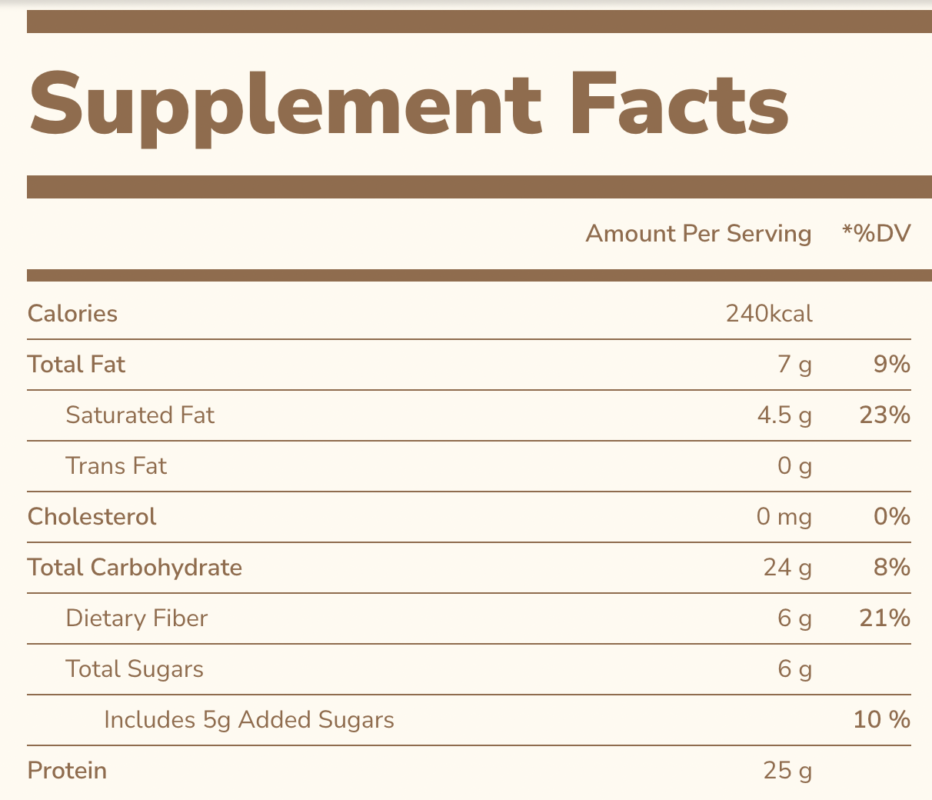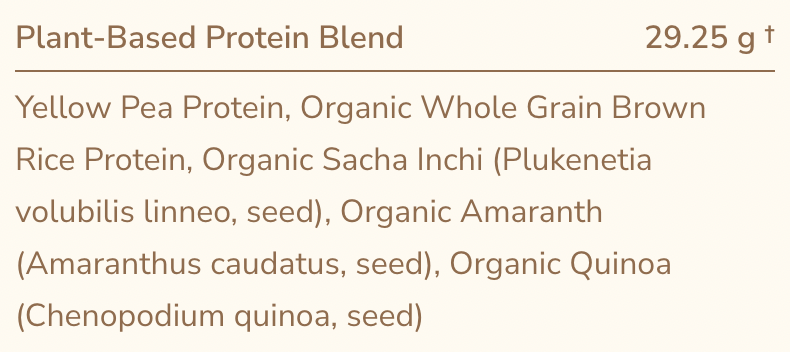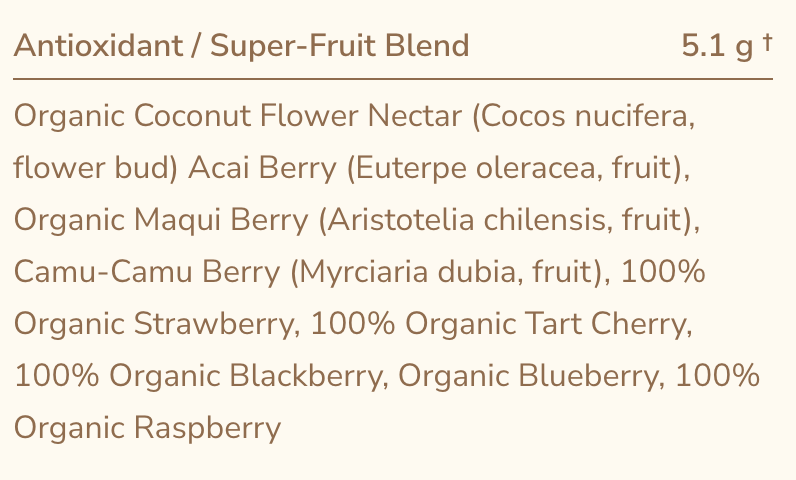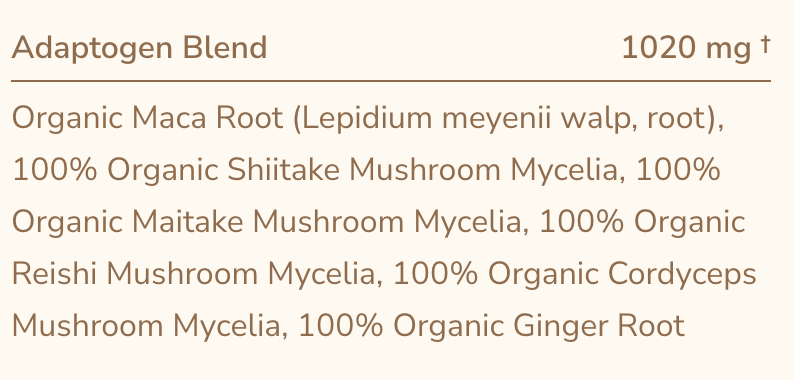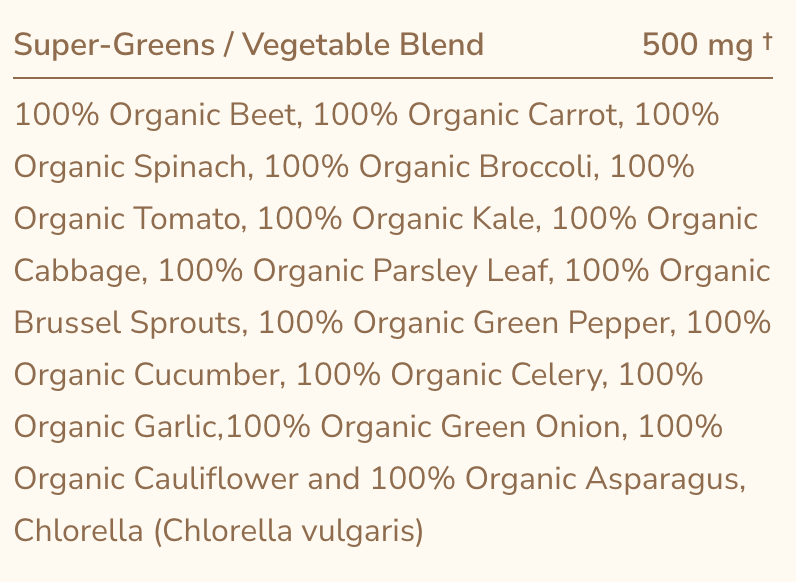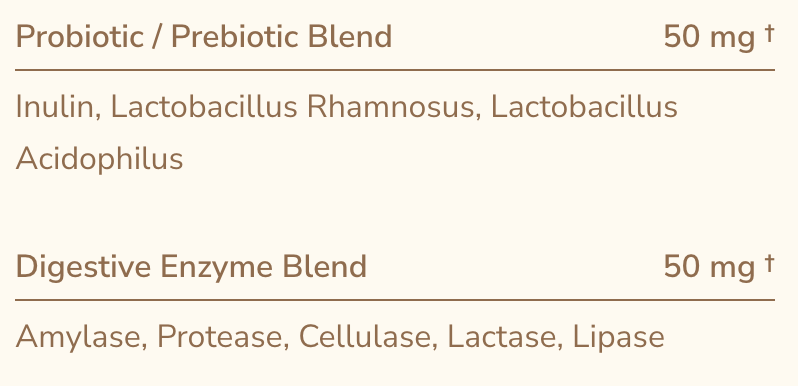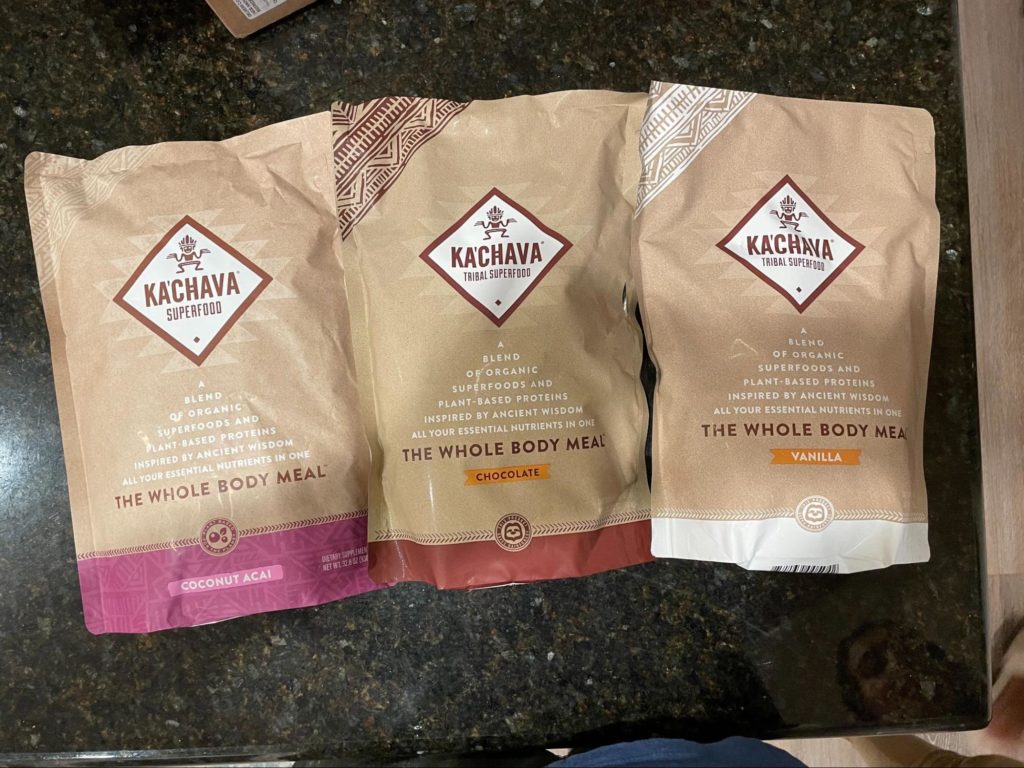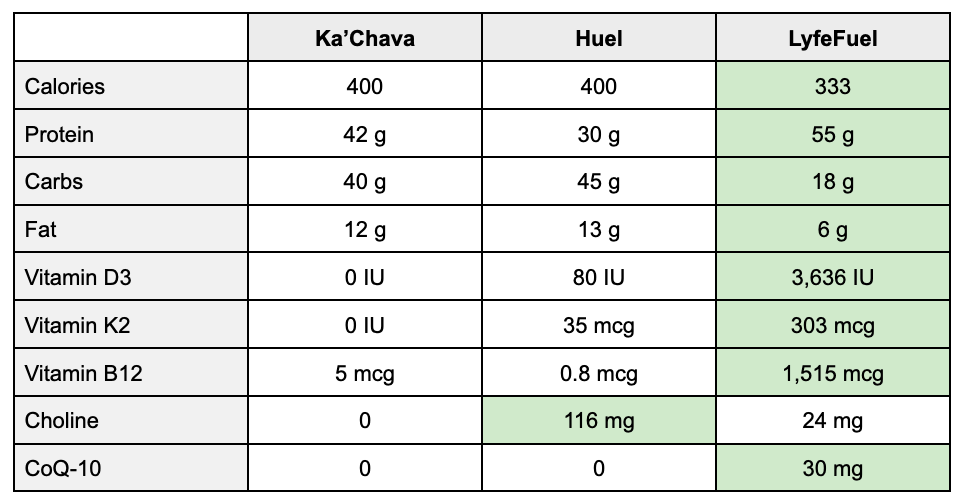A Comprehensive Ka’Chava Review: Pros, Cons and Healthier Alternatives
Ka’Chava curious?
Since you’re here, we’re guessing it’s because you’re researching the latest internet sensation in the meal replacement category called Kachava. By now, you’ve probably seen the Ka’Chava ads trolling your Instagram feed or plastered all over Google and YouTube and are ready to take a closer look at what’s really in this all-in-one protein powder.
With so much money being spent on brand advertising to lure in new customers, we thought it made sense to dive into the science (or lack thereof) behind their formulations and find out if this super-blend is super awesome or just super expensive.
Boasting 85+ superfoods, nutrients, and plant-based ingredients in a single shake, Ka’Chava has become one of the most popular brands in the nutrition drinks and shakes category. This is in part due to its “all natural” ingredients and hyped-up nutrient profile that positions the shake as the world’s most nutrient-dense meal and the secret to all our health woes.
Needless to say, we were skeptical.
For the average consumer, it can be tough to tell if something is truly worth the hype (and the money). We wrote this in-depth Ka’Chava review so that you can decide for yourself whether Ka’Chava is just another scam supplement company vying for a share of your wallet, or something you really should consider using as part of your daily wellness routine.
To sort fact from fiction and eliminate all subjective biases (like taste), we decided to break down this shake in its entirety by focusing on what matters most: ingredients & nutrition.
In this comprehensive Ka’Chava review, we’ll not only provide you with detailed insight into Ka’Chava products but also provide a short list of the best Ka’Chava alternatives with similar benefits so that you can make an informed decision about which product best fits your specific dietary needs and lifestyle.
Ready for a deep dive into the world of meal replacement shakes? Let’s get started!
Ka’Chava Ingredients and Nutrition Facts
First things first, let’s set the record straight. Ka’Chava is NOT made from 85+ superfoods. Count the number of ingredients on the supplements panel. You’ll see that it contains approximately 45 “superfoods” that contribute (in part) to 26 micronutrients plus protein, carbs, and fat, with a probiotic and digestive blend thrown in for good measure.
Based on their recent ads, even the Ka’Chava team doesn’t really know what’s really going into their glorified protein powder…is 70+ plant-based superfoods & nutrients or 85?
Needless to say, based on first impressions and this inconsistent (somewhat deceitful) messaging we were skeptical.
Another key distinction is that the vitamins and minerals are synthetically derived, not whole food sourced, which is pretty misleading by the way that it’s positioned in their marketing. But we aren’t going to solve all the problems with the supplement industry in a single article so we digress.
When it comes to making smart and healthy food choices, knowing the facts can make a big difference! Ka’Chava positions itself as an all-in-one plant-based meal replacement powder that is designed to provide the body with all of the essential nutrients it needs to function properly.
Touting itself as the “healthiest shake imaginable,” we were eager to dig into some of these claims to find out if it really lives up to the hype.
A quick look at the supplement facts panel would be enough to impress most consumers. But, dig a little deeper, and you’ll discover that there’s more to what meets the eye. We broke down each Ka’Chava ingredient section to take a closer look at the macro and micronutrients in each of their proprietary blends.
We’re hoping this intensive review will make it easier to understand exactly what you’re getting in this $5-per-serving meal shake before you buy.
Macronutrient Breakdown: Protein, Carbs, and Fats
Just ask any keto dieter, and the first thing you’ll learn is that out of the three macronutrients, only two are actually deemed essential for human nutrition – protein and fats. At 25 grams per serving Ka’Chava certainly packs a decent amount of protein into their meal replacement powders. As for carbohydrates, it’s in the mid-range for carbohydrates which consists of 6 grams of sugar and 6 grams of fiber. Rounding out the macros are 7 grams of fat, which appear to be derived from coconut milk, flaxseed, and chia.
Overall, the macronutrient profile is similar to what you’d expect in most meal replacement shakes. However, 6 grams of sugar and 25 grams of carbs could be problematic for certain consumers like those with Type II Diabetes, insulin resistance, anyone following a ketogenic diet, and those looking to use meal replacement shakes for weight loss.
However, if you’re simply looking for a quick and convenient meal as a better alternative to fast food and or simply don’t have time to cook and meal prep, then Ka’Chava is a good option.
With the macros out of the way, it’s time to dig into the finer details of the Ka’Chava formulation.
The Ka’Chava meal shake uses a combination of 7 different blends plus a synthetic vitamin & mineral mix. Contradictory to their claims of being sourced from 85+ superfoods is the micronutrient panel, which was synthetically created in a lab…not derived from 100% real whole foods. But more on that later on. For now, let’s look at everyone’s favorite nutrient…protein!
Ingredient Review – Plant-Based Protein Blend
As we pointed out earlier, the Ka’Chava protein blend has 25 grams (g) of protein per serving from a range of protein sources like yellow pea protein, sacha inchi, brown rice protein, amaranth, and quinoa. Ka’chava doesn’t post the amino acid breakdown anywhere on the packaging or website, so it’s unclear whether their plant-based protein protein blend is a complete protein with a PDCAAs score of 1.0 or greater.
What’s a PDCAAs score, you ask? Quite simply, the PDCAAS is a scientific method for measuring protein quality. PDCAAS stands for Protein Digestibility Corrected Amino Acid Score. Most animal-based proteins have a PDCAAs of 1.0, whereas isolated plant proteins usually have something less than that of around 0.6 – 0.8.
Why is this important? It simply means that if the source of protein is lower than 1.0 you’re not getting all the bang for your buck when it comes to essential amino acids. The trick to overcoming this with plant proteins is by combining complementary sources of protein like peas and rice. Ka’Chava does use different types of protein, but it’s unclear if this combination meets the criteria.
Savvy label readers (like us) may have picked up on something here. The macronutrient profile states 25 grams of protein, but the protein blend shows 29.25 grams of protein. What this means is that the protein blend being used is only about 85% protein by volume. The additional 4.25 grams are carbohydrates, not protein.
Our Rating: 4.5 out of 5.0
With a shake this expensive, we were expecting to see more organic ingredients used for their protein blend. They do a decent job of combining protein sources to achieve a complete protein, but it’s not clear what this translates to in terms of protein quality. In general, most people tolerate plant-based protein better than whey protein, which is known to cause digestive issues and an inflammatory response in the majority of people.
Ingredient Review – Omega EFA/Fiber Blend
Dietary fiber is associated with weight loss in overweight and obese individuals, as it’s zero-calorie and helps you feel fuller and faster. However, it is often lacking in the diets of most people.
Ka’Chava offers 6 grams of fiber per serving, which is sourced from a variety of soluble fibers such as oats, acacia gum, flax, and chia.
While true that oats, flax, and chia offer some omega fatty acid content, it’s likely not enough for most individuals to rely on as their sole source of omega-3 fatty acids. This is due to the poor conversion of the type of fatty acids (alpha lipoic acid) into the essential fatty acids used by your brain and body like EPA and DHA.
Similar to the protein blend, you’ll see that the fiber blend contains more raw materials than the yield in the macronutrients. It lists 11.12 grams as omega and fiber, but only 6 grams of total fiber are listed on the main supplement facts panel.
As for the omega-3 fatty acids, our guess is that there are only around 1-2 grams (max) of flax & chia, which is pretty low for the typical recommendation for these superfoods when used as an essential fatty acid supplement.
Combine this with the lack of essential brain nutrients like choline missing from their formula means that the benefits of “mental health” are grossly overstated. That said, 6 grams of fiber should help you feel full – which is one of the main reasons why people use meal replacement shakes – to begin with.
Our Rating: 4.0 out of 5.0
It’s great to see a couple of organic ingredients being used here but unfortunately, they are a far cry from the “premium ingredients” the brand claims to use. Oats are notorious for being one of the cheapest sources of calories available…although that could all change with all the supply chain disruptions and increased demand for oat milk beverages. Our primary reason for the 4-star rating was that we found the “EFA” blend to be a bit misleading. Fiber blend…sure, but essential fatty acids? That’s a stretch.
Ingredient Review – Antioxidant / Superfruit Blend
The fruit and vegetable blends in Ka’Chava have a long list of ingredients, with organic coconut flower nectar as the highest dose. This is a much healthier alternative compared to added sugar due to its unrefined nature. However, it is not as nutritious as other sweeteners used in other meal replacements.
The odd thing here is that Ka’Chava seems to be hiding the coconut nectar under the superfruit/antioxidant blend instead of listing it as an “other ingredient” at the bottom of the supplement label. Last we checked, sugar…in all forms is not considered a superfood.
Hiding things in a proprietary blend makes it difficult for the consumer to judge how healthy these ingredients are. What we do know based on the ordering of the ingredients is that sugar (coconut nectar) is the primary ingredient in their antioxidant/superfood blend. With 6 grams of added sugar on the label and just 5 grams of superfruits anchored by coconut nectar, you’re getting just trace amounts of everything else listed here.
Our Rating: 1.0 out of 5.0
We’re not going to jump to any conclusions as to why Ka’Chava chose to hide added sugar in their superfruit blend, but we can say that by doing so, it definitely dilutes one of the key tenets of their shakes, the superfoods. Since the consumer is unable to assess how much nutritional value they’re actually receiving – outside of the fact that all of the ingredients listed are whole foods – it’s safe to say that there are better options out there with more transparent nutrition facts.
Ingredient Review – Adaptogen Blend
In Ka’Chava’s Adaptogen blend, the brand lists maca root, which is very hard to digest raw. Generally, maca root is consumed in a gelatinized or extract form to avoid digestive discomfort and improve absorption.
Because all the adaptogenic ingredients are combined in a blend, it’s not clear how much of each ingredient is actually included in the product.
As an example – one of the ingredients in Ka’Chava is ginger root, and a recent study published in the Herbal Medicine journal found that the effective range was 250-4,800mg per day. This is an incredibly low dosage, making it unlikely that these ingredients – while good – will do anything for the consumer.
Our Rating: 3.5.0 out of 5.0
The ingredients themselves are actually quite impressive, but it’s impossible to know how beneficial they are without knowing the amount included and the sourcing. For example, the mushrooms don’t state whether they are mycelium, fruiting bodies, extracts, or whole plant sources. The fact that they’re not more transparent about this information leads us to believe that they are using whatever is cheapest and not necessarily what is best for the consumer.
Ingredient Review – Super Greens / Vegetable Blend
The one thing we appreciate about the Ka’Chava greens blend is that all the ingredients listed (except for chlorella) are organic. The downside is that at just 500 mg per serving, the greens in this product are doing almost nothing to improve health. Most greens powders are between 2 – 10 grams to deliver a comparable amount of phytonutrients that you’d get from a whole serving of veggies.
Again, at first glance, the blend looks great However, upon closer inspection, you’re not really getting your money’s worth. If the veggie blend was as nutrient-rich as it should be, then there wouldn’t be any need for Ka’Chava to fortify the product with synthetic vitamins & minerals. But, synthetic vitamins are a cheaper alternative to real whole foods, which seems to be a repeating pattern here.
Our Rating: 2.0 out of 5.0
There’s no replacement for real whole foods. Still, if upping your daily greens is what you’re after, you’d be better off using a greens powder that uses cold-pressed processing and delivers a higher concentration of green vegetables than what you’d get in a Ka’Chava shake.
Ingredient Review – Probiotics & Digestive Enzymes
Ka’Chava has both a probiotic/prebiotic blend and a digestive enzyme blend. Typically, probiotics are almost always listed by colony forming units (CFU) on Supplement Facts labels. The usage of CFU is due to it being the medical dosage standard.
However, Ka’Chava lists the probiotic species but not the probiotic strain. This is not standard and leaves customers without the information necessary to determine if there is an appropriate dose of probiotics.
A more effective method of improving gut health is to feed the good bacteria in the gut with the fuel they need to thrive, which comes in the form of prebiotic fiber.
Additionally, no medical research suggests that people without digestive health conditions need supplemental digestive enzymes, making the inclusion of such by Ka’Chava unnecessary.
Our Rating: 1.0 out of 5.0
The science of gut health has come a long way. It’s evolved beyond the idea that everyone should be taking probiotics because they’re good for us to be more specialized and sophisticated according to a person’s unique microbiome.
There’s not enough evidence to suggest that the probiotic & enzyme blend that Ka’Chava is using has any benefit to gut health, and there’s no information on their website about where the bacteria come from and whether they’re shelf-stable or dead on arrival.
Ingredient Review – Vitamins and Minerals
Ka’Chava contains a lengthy list of added vitamins and minerals used to fortify the glorified protein shake as a way to fit it into the meal replacement shake category. Without the synthetic vitamins & minerals, the product would not appear to be nearly as nutritious and would just be another expensive protein powder.
We do appreciate the added vitamins & minerals because studies show that most people are lacking in key vitamins and minerals. The problem here is that Ka’Chava apparently forgot to do their research. There are a few key nutrients that are absent from their formulation, most notably choline, Vitamin K2, and CoQ-10. What’s more, is that they use the less bioavailable forms of nutrients like Vitamin D2 instead of D3 and cyanocobalamin instead of methylcobalamin for B12 to name a few.
Our Rating: 3.5 out of 5.0
Ka’Chava provides a decent list of vitamins and minerals, but there’s nothing special about the micronutrients delivered. Certain nutrients are too low to be effective at filling the most common nutritional gaps of modern diets. But, it really depends on the individual user and what their goal is for using the product in the first place.
If the goal is simply to replace a meal then, yes, Ka’Chava does a decent job at providing some nourishment in place of food. However, if it is complete nutrition that you’re after, you’d likely need to fork over additional money on supplements to compensate for the essential nutrients missing from the Ka’Chava shakes.
Ingredient Review – Fillers, Flavors & Sweeteners
The Ka’Chava superfood blend contains a shortlist of additional ingredients which aren’t as scary as what you’d typically see on products in the nutrition drinks and shakes category. Overall, Ka’Chava offers a clean label of wholesome ingredients.
One thing that stands out is the xanthan gum and guar gum used, which likely contain other carrier ingredients like maltodextrin. Because supplement manufacturers don’t have to disclose this on the label, it’s not clear whether they use genetically modified corn maltodextrin or a cleaner alternative like tapioca maltodextrin.
Our Rating: 4.5 out of 5.0
The added ingredient list is short and easy to understand, which is always important when deciphering a nutrition label. We appreciate their use of monk fruit as a sweetener, a clean and natural alternative to the artificial sweeteners that are all too common in the meal replacement category.
Does Ka’Chava have any side effects?
It’s unlikely that Ka’Chava will cause side effects, as its ingredients are (mostly) whole. However, there is not much scientific evidence about Ka’Chava’s long-term impact on health or if it might cause side effects.
While reviews from Ka’Chava consumers indicate no major issues with the product, it has never been studied in a clinical trial, so it remains unclear whether it could potentially cause any side effects.
Reading the thousands of positive reviews on Amazon and the brand’s website, it’s clear that there are many people who have purchased this shake and enjoy the product. According to Fakespot, an online reviews analyzer tool gives the brand a “D” overall, which we think is a bit harsh. Generally speaking, most people would benefit from using something like Ka’Chava as part of their daily wellness routine.
The only potentially concerning thing we could find is a 2021 lawsuit filed against Tribal Nutrition LLC (Ka’Chava business name) by the Environmental Research Center that states potentially harmful levels of heavy metals in the product, which resulted in it being temporarily removed from Amazon.
Keeping in mind that anything coming from the earth will contain some level of heavy metals, the California Prop-65 guidelines are 100 times more restrictive than what the federal guidelines have deemed as potentially harmful to humans it’s not easy to know how “harmful” the levels of heavy metals were, but we felt it was important to point it out so that you can make an informed decision for your health.
As always, make sure to consult a healthcare professional before making any major changes to your diet or adding dietary supplements.
Taste & Mixability
Of the 5 flavors offered by Ka’Chava (chocolate, vanilla, acai berries, matcha, and chai) we personally tried the vanilla flavor, chocolate flavor, and acai berry flavor. The directions recommend mixing 2 heaping scoops (60 grams) of the meal replacement powder with water or milk. We first tried the chocolate flavor in just water and found that it had a nice consistency and decent flavor. Chocolate was by far the best of the three we tried.
As for the vanilla flavor, it was decent but tasted a bit artificial, which is likely due to the natural flavors and not including the actual vanilla bean itself. The acai was our least favorite and actually caused a significant amount of gastric irritation, leaving us bloated and very gassy. It tasted more like bubble gum than acai which is known to have a sour and subtly sweet taste.
Overall the product mixed well but we had to add more liquid to it to thin it out a bit.
Ka’Chava: Is it Worth It?
It’s easy to be convinced by all the positive customer reviews that Ka’Chava is one of the best meal replacement powders on the market. At first glance, it checks all the boxes – no artificial ingredients, low sugar content, a wide range of superfoods and natural ingredients, a decent blend of vitamins, and a rich source of antioxidants. What more could you ask for in a dietary supplement?
Well, if quality ingredients and science-backed nutrition is important to you there are other options that deliver more value per serving than Ka’Chava. Keep reading for our top Ka’Chava alternatives that are better options for controlling blood sugar, supporting a broader range of health goals, and better equipped to aid in weight loss and metabolic health.
Best Ka’Chava Alternatives
Now that we’ve broken down the Ka’Chava nutrition shake in its entirety, you may be convinced that it’s everything you need and more! Or, like us, you may be wondering if there are any other products out there that offer a comparable or even more complete nutritional profile without the crazy price of Ka’Chava.
What follows is a short list of the top Ka’Chava alternatives that offer a similar nutritional profile but might be more in line with what you’re looking for.
Ka’Chava vs 310 Nutrition Shakes
When it comes to meal replacement products, Ka’Chava and Nutrition 310 are two of the most popular options on the market. Unfortunately, neither of them offers a balanced approach to health and wellness.
Ka’Chava has an impressive ingredient list of whole foods, but having too many additive ingredients can be toxic for some. Nutrition 310, on the other hand, lacks micronutrients and essential fatty acids – making it a subpar meal replacement and better used as a protein powder with some added nutrients. If you’re seeking a complete meal replacement product, there are likely better options on the market that fit your lifestyle and dietary needs.
After scouring the internet for the best meal replacement shakes, we’ve narrowed it down to 3 options: Ka’Chava, Huel, and LyfeFuel. All 3 three companies offer products in the meal replacement category that are free from artificial ingredients, have positive customer reviews, and offer a well-rounded mix of natural ingredients, there is one product in particular that stands out among the rest.
Macro & Micronutrients per 100 grams:
Ka’Chava vs Huel
Consumers have long compared Ka’Chava and Huel, wondering which is the better alternative. While both are vegan, non-GMO meal replacements that promise to provide a full range of nutrients when consumed, there are some differences in their ingredients.
Ka’Chava features whole-food ingredients blended into its formula. On the other hand, Huel takes a high-protein, low-carb, and low GI approach that includes some processed ingredients. What both of these options have in common, however, is that they both have non-essential additives in their formulas.
Although both offer certified organic or all-natural ingredients, there are better alternatives on the market. With so many different types of meal replacements on the market today, it is best to look beyond Ka’chava and Huel to find something that meets one’s specific needs.
Ka’Chava vs Lyfe Fuel
If you’re looking for a complete nutrition shake that can also replace a meal, LyfeFuel may be just what you’re looking for and quite literally exactly what the doctor ordered. It contains premium ingredients such as organic sprouted brown rice, organic alfalfa grass and grape seed extract that help give your body all the essential nutrients it needs.
Unlike Ka’Chava, the brand uses the latest nutritional information to design their formulations, looking to the research of thought leaders like Dr. Bruce Ames to guide their development. According to the brand’s website, they start with science and look to nature to source the world’s most nutrient-dense ingredients with the goal of putting back what’s missing from food.
What we love most about LyfeFuel is not just that it’s packed with organic versions of some of the superfoods that you’ll also find in Ka’Chava but their commitment to sustainability, transparency, and efficacy when selecting which types of ingredients to include.
For example, they use Vitamin D3 instead of D2, they include things like choline, Co-Q10, and methylated B12, and are working towards sourcing 100% organic whole food ingredients.
So if clean ingredients in a science-backed formulation are what you’re looking for, LyfeFuel is the wholesome and healthier option. But before you make a decision, let’s get into some details about what sets this shake apart from its competitors.
What’s the difference between Ka’Chava and Lyfe Fuel?
Ka’Chava and Lyfe Fuel may look and sound like very similar products, but in fact, they offer two distinct types of nutrition. Ka’Chava is more of a standard meal replacement shake that contains a broad set of nutrients designed to provide the consumer with the basic requirements to replace a meal.
On the other hand, LyfeFuel’s main focus is on providing complete nutrition in a single shake. Like Ka’Chava, it includes all the essential macronutrients and micronutrients but takes this a step further by turning their focus toward the vitamins & minerals that are missing most.
Additionally, their complementary protein source of pea protein and organic sprouted brown rice results in a PDCAAS of 1.0, which means you’re getting more out of what you’re putting in.
Both lower in calories (110 per serving) and lower in carbohydrates (6 grams), it is a better option for anyone following a keto diet or looking into meal replacement shakes for weight loss but would not be the ideal choice for anyone looking at meal replacement shakes for weight gain or someone looking for a high-calorie meal shake.
LyfeFuel points out that their shake is equally equipped to control hunger due to the higher concentration of nutrients which delivers more nutrition in a single scoop (33 grams) than Ka’Chava does with two (60 grams).
Both Ka’Chava and LyfeFuel are great for people looking for different forms of nutrition but their differences make them suitable for specialized health needs.
Our Top Pick for the Best All-in-One Nutrition Shake
LyfeFuel is really in a category of its own. Not a meal replacement by conventional standards and certainly more than a greens powder or multivitamin, hands down! It’s filled with a mix of premium plant-based proteins, nourishing micronutrients, and powerful superfoods that provide the perfect balance of nutrients to fuel your day. Plus, it is low in sugar and calories, vegan, gluten-free, and keto-friendly, making it a healthy choice for just about anyone looking to maintain weight or reach their fitness goals.
Offered in both chocolate flavor and vanilla chai, each flavor of LyfeFuel contains a unique set of vitamins, minerals, and antioxidants, so no matter what you choose, you can be sure you’re nourishing your body with natural goodness. Not only that, but each serving is made without artificial flavors or added sweeteners, so it tastes great without compromising on nutritional integrity! For an easy way to get all the nutrition and energy you need in one meal, look no further – LyfeFuel’s got you covered.
The Most Complete Ka’Chava Review: Final Thoughts
Ka’Chava is a decent meal replacement shake and has some good ingredients, but it doesn’t pack the same nutritional punch as LyfeFuel. If you want a truly balanced meal replacement that will give you sustained energy throughout the day, we recommend trying LyfeFuel’s Daily Essentials Shake.
So what are you waiting for? Give LyfeFuel’s Essentials Nutrition Shake a try today! It won’t disappoint you.

